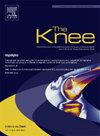日本男性三束前交叉韧带重建术后肌肉截面积和膝关节、踝关节功能随时间变化的差异,符合恢复运动标准者与不符合恢复运动标准者
IF 2
4区 医学
Q3 ORTHOPEDICS
引用次数: 0
摘要
背景下肢肌肉是前交叉韧带重建(ACLR)的主要康复目标。本研究旨在探讨ACLR患者下肢肌肉横截面积(MCSA)的时间变化。方法选取27例行ACLR的男性患者,分为PASS组和non-PASS组。在所有跳跃测试中,PASS的损伤与未损伤性能之比超过90%,Lysholm评分≥90。那些未能达到其中一项条件的学生被指定为非及格学生。关于MCSA,我们获得了损伤侧下肢的磁共振图像。股四头肌、腘绳肌、腓肠肌和比目鱼肌在每个肌肉的最大MCSA切片处进行人工围合。测量膝关节和踝关节的活动范围(ROM)和肌肉力量。在术前(PRE)和aclr后3、6、9和12个月(分别为POST3/POST6/POST9/POST12)测量所有参数。使用KT-1000测量接受二次手术患者的膝关节稳定性。显著性水平设为5%。结果在POST12中,与非PASS组相比,PASS组(n = 14)表现出更大的踝关节背屈度、膝关节伸展强度和踝关节跖屈强度。没有检测到MCSA的相互作用,因此这两个数据被整合到一个统一的组中进行事后测试。POST12的股四头肌MCSA明显大于PRE。POST12组的腘绳肌、腓肠肌和比目鱼肌mcsa与PRE组相比无显著差异。结论踝关节功能和力量的恢复可能是恢复运动的重要因素。本文章由计算机程序翻译,如有差异,请以英文原文为准。
Difference in time-course change in muscle cross-sectional area and knee and ankle functions between Japanese male patients who meet the return-to-sport criteria and those who do not meet it after triple-bundle anterior cruciate ligament reconstruction
Background
The lower-extremity muscles are the main target of rehabilitation post-anterior cruciate ligament reconstruction (ACLR). This study aimed to investigate time-course changes in the cross-sectional area of lower-extremity muscles (MCSA) among ACLR patients.
Methods
Twenty-seven male patients who underwent ACLR were included and grouped into PASS and non-PASS. PASS could achieve a ratio of injured-to-uninjured performance surpassing 90 % in all hop-tests and Lysholm score of ≥ 90. Those who failed to achieve even one of those conditions were designated as non-PASS. About MCSA, magnetic resonance images of the lower extremity on the injured side were obtained. Quadriceps, hamstrings, gastrocnemius, and soleus were manually surrounded at the slice featured the maximal MCSA for each muscle. Range of motion (ROM) and muscle strength of the knee and ankle were measured. All parameters were measured before surgery (PRE) and at 3, 6, 9, and 12 months post-ACLR (POST3/POST6/POST9/POST12, respectively). Knee stability was measured using KT-1000 in patients who underwent second-look surgery. The significance level was set at 5 %.
Results
At POST12, PASS (n = 14) exhibited greater ankle dorsiflexion ROM, knee extension strength, and ankle plantarflexion strength than non-PASS (n = 13). The interaction of MCSA was not detected, thus both data were integrated into a unified group for post-hoc tests. Quadriceps MCSA at POST12 was significantly larger than that at PRE. Hamstring, gastrocnemius, and soleus MCSAs at POST12 did not have significant differences than those at PRE.
Conclusions
Restoration of ankle function and strength may be important for returning to sports.
求助全文
通过发布文献求助,成功后即可免费获取论文全文。
去求助
来源期刊

Knee
医学-外科
CiteScore
3.80
自引率
5.30%
发文量
171
审稿时长
6 months
期刊介绍:
The Knee is an international journal publishing studies on the clinical treatment and fundamental biomechanical characteristics of this joint. The aim of the journal is to provide a vehicle relevant to surgeons, biomedical engineers, imaging specialists, materials scientists, rehabilitation personnel and all those with an interest in the knee.
The topics covered include, but are not limited to:
• Anatomy, physiology, morphology and biochemistry;
• Biomechanical studies;
• Advances in the development of prosthetic, orthotic and augmentation devices;
• Imaging and diagnostic techniques;
• Pathology;
• Trauma;
• Surgery;
• Rehabilitation.
 求助内容:
求助内容: 应助结果提醒方式:
应助结果提醒方式:


